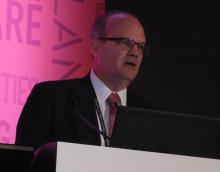People at increased risk for atrial fibrillation who wore a screening ECG patch for about 2 weeks had their arrhythmia diagnosis rate boosted by 200%-800% during 4 months of follow-up, compared with conventionally followed adults in a randomized, novel-design trial with more than 2,600 randomized participants.
The patients who wore an ECG patch had a 3.9% rate of atrial fibrillation (AF) diagnosis in the study’s intention-to-treat analysis, and a 5.1% rate in the per protocol analysis that were the coprimary endpoints for the study, compared with rates of 0.9% and 0.6%, respectively, among people followed with usual care and diagnosed with AF based only on clinical findings.
Patients who underwent ECG screening for AF using a patch, compared with those followed with usual care, had more AF diagnoses, greater treatment with anticoagulation over the following year, and increased use of health care resources after 1 year, Steven R. Steinhubl, MD, and his associates reported in JAMA.
The mSToPS (mHealth Screening to Prevent Strokes) trial enrolled adults covered by an Aetna commercial or Medicare health plan who fell into a high-risk group for AF onset: Those aged 75 years or older or with at least one of several specified comorbidities. This identified more than 359,000 eligible insured patients. Dr. Steinhubl and his associates invited more than 100,000 people to participate, of whom 2,659 consented and met further eligibility screens. They randomized these people to either undergo immediate ECG patch screening, or have their screening delayed for 4 months while undergoing clinical follow-up.
The researchers sent two commercially available patches to the 1,366 people randomized to immediate screening, with instructions that they wear one patch for 2 weeks immediately, and wear the second patch for 2 weeks starting 3 months after they removed the first patch. Participants mailed their patches to a central site for analysis. Diagnosis of AF was based on an adjudicated episode of at least 30 seconds, and the researchers alerted participants and their individual physicians about diagnostic positives.
Among the 1,366 immediate patch recipients, a third never wore a patch for at least 30 minutes and were excluded from the per protocol analysis. The 908 patch users from the immediate screening subgroup as well as the patch users from the delayed subgroup wore each patch for an average of nearly 12 days, and about two-thirds wore both assigned patches. People diagnosed with AF had, on average, nearly 10 discrete episodes during screening, with a median episode duration of 186 minutes. The median AF burden among those who screened positive was 0.9%, reported Dr. Steinhubl, a cardiologist and director of digital medicine at the Scripps Translational Science Institute in La Jolla, Calif.
The researchers also compared medical interventions during the year following entry among all 1,738 screened patients (from both the immediate and delayed screening subgroups) and a matched group of 3,476 unscreened people who had consented to participate in the study. This showed that AF screening was linked to a doubled rate of anticoagulant treatment initiation. The ECG patch screening also identified 70 additional people with various other potentially actionable cardiac arrhythmias.


